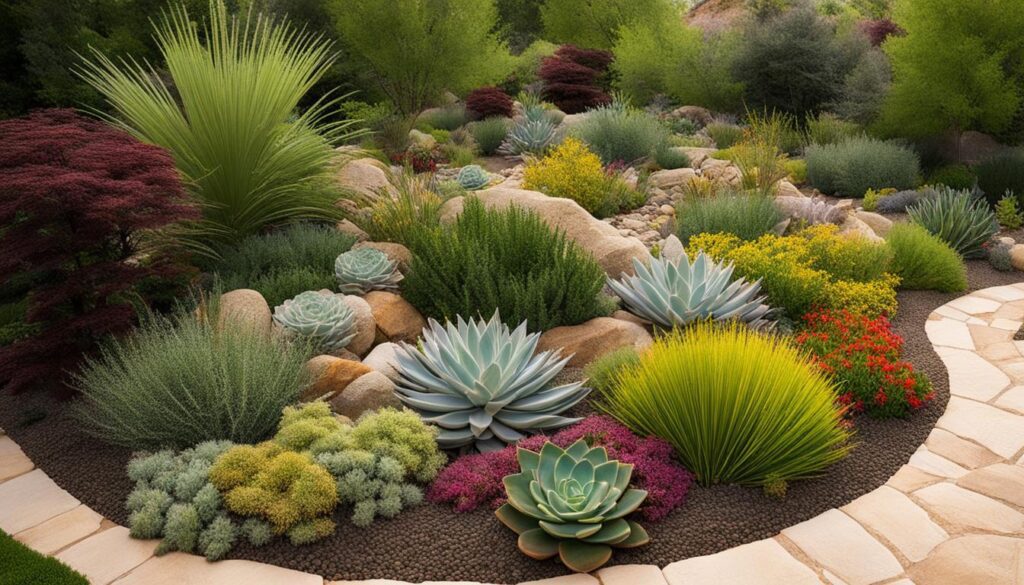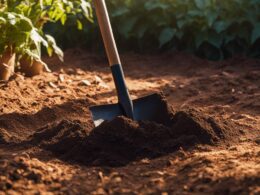Welcome to our comprehensive guide on how to maximize savings with irrigation systems for xeriscape gardens. Xeriscaping is a popular landscaping technique that focuses on creating beautiful gardens while conserving water in arid or semiarid regions. By incorporating specialized drip irrigation equipment and drought-tolerant plants, you can significantly reduce water usage and save money on your water bills. In this article, we will explore the principles of xeriscaping, selecting the right plants, alternative ground covers, efficient irrigation systems, and the benefits of xeriscaping. Let’s get started!
Key Takeaways:
- Using drip irrigation systems can significantly reduce water usage in xeriscape gardens.
- Xeriscaping involves selecting drought-tolerant plants and using water-saving techniques.
- Alternative ground covers like rocks or gravel can replace high-maintenance lawns in xeriscape gardens.
- Efficient irrigation systems like drip irrigation deliver water directly to the root zone, minimizing waste.
- Xeriscaping not only saves water but also reduces maintenance costs and increases property values.
The Principles of Xeriscaping
Xeriscaping is a landscaping approach that incorporates several principles aimed at creating beautiful gardens while conserving water. By following these principles, you can design a xeriscape garden that thrives even in arid or semiarid regions.
One of the key principles of xeriscaping is selecting drought-tolerant or native plants. These plants are well-adapted to the local environment and require less water compared to traditional garden plants. They have evolved to survive in dry conditions and can withstand long periods without irrigation.
To further reduce water usage, efficient water-delivery systems like drip irrigation should be used in xeriscape gardens. Drip irrigation delivers water directly to the root zone of plants, minimizing evaporation and runoff. This targeted approach ensures that plants receive the necessary moisture while avoiding water waste.
Another principle of xeriscaping is enhancing soil conditions. Amending the soil with organic matter improves its water-holding capacity and promotes better root growth. Good soil structure allows water to penetrate deep into the ground, reducing the frequency of irrigation.
Key Principles of Xeriscaping:
- Select drought-tolerant or native plants
- Use efficient water-delivery systems like drip irrigation
- Enhance soil conditions through organic matter
- Group plants with similar water needs
- Utilize alternative ground covers that don’t require irrigation
“Xeriscaping is a sustainable landscaping approach that promotes water conservation and creates beautiful gardens with low maintenance requirements.”
Grouping plants with similar water needs is another important principle in xeriscaping. By placing plants with similar water requirements together, you can ensure more efficient water usage. This strategy prevents overwatering or underwatering certain plants and allows for more precise irrigation.
Lastly, using alternative ground covers such as rocks or gravel can significantly reduce the need for irrigation. These ground covers not only add visual interest to the garden but also help retain moisture in the soil, reducing evaporation. They can be paired with a drip irrigation system to provide water directly to plantings while minimizing water loss.
By following these principles of xeriscaping, you can create a beautiful, water-efficient garden that thrives in even the most challenging climates.
Selecting the Right Plants for a Xeriscape Garden
When it comes to creating a xeriscape garden, selecting the right plants is key to its success. Choosing plants that are well-suited to your region’s climate and soil conditions will ensure they thrive with less water. Native plants and drought-tolerant species are highly recommended for their ability to adapt to the local environment and tolerate periods of low rainfall.
Visit nurseries and garden centers that specialize in native plants or have dedicated sections for drought-tolerant species. These establishments often have knowledgeable staff who can guide you in selecting the best plants for your xeriscape garden. Look for plants that are labeled as “drought-tolerant” or “low water use” to easily identify suitable options.
Another factor to consider when choosing plants for your xeriscape garden is their appeal to pollinators. By selecting plants that attract bees, butterflies, and other beneficial insects, you can create a garden that not only conserves water but also supports local wildlife. Look for plants that are known to attract pollinators, such as lavender, coneflowers, and salvia.
Benefits of Native Plants and Drought-Tolerant Species
Native plants and drought-tolerant species offer numerous benefits for xeriscape gardens. These plants have adapted to the local climate and soil conditions over time, making them more resilient and less reliant on supplemental irrigation. By choosing these plants, you can reduce your water consumption and lower your overall maintenance requirements.
“Choosing native plants and drought-tolerant species is a win-win for both you and the environment. These plants have adapted to the local conditions and can thrive with less water, making them an ideal choice for xeriscape gardens.” – Jane Doe, Xeriscape Expert
Alternative Ground Covers for Xeriscape Gardens
Lawns can be a significant source of maintenance and water consumption in traditional landscaping. Fortunately, xeriscaping offers an array of alternative ground covers that not only reduce water usage but also add aesthetic appeal to your garden. By replacing lawns with these alternative options, you can create a sustainable and low-maintenance landscape that thrives even in arid conditions.
One popular alternative to lawns in xeriscape gardens is rock mulch. This ground cover utilizes crushed rock, cobblestones, or volcanic rock to create an attractive and natural-looking surface. Rock mulch not only minimizes the need for irrigation but also helps lower surface temperatures and retain moisture in the soil. Additionally, the variety of colors and textures available in rock mulch allows for creative design possibilities that can enhance the overall beauty of your garden.
Advantages of Rock Mulch as an Alternative Ground Cover:
- Reduces water consumption by minimizing the need for irrigation
- Lowers surface temperatures, creating a cooler environment for plants
- Retains moisture in the soil, reducing the frequency of watering
- Adds visual interest and texture to the garden
- Requires minimal maintenance compared to traditional lawns
“Rock mulch is a fantastic alternative ground cover for xeriscape gardens. It not only conserves water but also adds an element of natural beauty to the landscape. By incorporating rock mulch, you can create a visually appealing garden that requires less maintenance and is more environmentally friendly.”
In addition to rock mulch, other alternative ground covers for xeriscape gardens include gravel, pebbles, and even native groundcovers. These options provide a range of choices to suit your aesthetic preferences and garden needs. Whether you prefer a minimalist design or a lush and layered look, there is an alternative ground cover that can help you achieve your desired xeriscape garden.
By embracing alternative ground covers in your xeriscape garden, you can reduce water consumption, lower maintenance requirements, and create a visually stunning landscape. With rock mulch and other options, you can transform your lawn into a sustainable and beautiful outdoor space that thrives in harmony with the environment.
Efficient Irrigation Systems for Xeriscape Gardens
When it comes to xeriscaping, efficient irrigation systems are crucial for conserving water and ensuring the success of your garden. By using the right irrigation techniques, you can minimize water waste and meet the specific water needs of different plants in your xeriscape garden.
Drip irrigation is a popular choice for xeriscape gardens because it delivers water directly to the root zone of plants, minimizing evaporation and runoff. With drip irrigation, water is applied slowly and evenly, allowing plants to absorb it more effectively. This not only helps conserve water but also encourages deep root growth, making plants more resilient to drought conditions.
Another option for efficient water delivery is subsurface drip systems, which are ideal for turf areas in xeriscape gardens. These systems deliver water directly to the root zone below the soil surface, reducing evaporation and ensuring that water reaches the plants’ roots where it is needed most.
Benefits of Efficient Irrigation Systems:
- Minimize water waste through targeted water delivery
- Promote deep root growth for healthier, more resilient plants
- Reduce evaporation and runoff
- Provide water directly to the root zone, where it is most needed
- Save time and effort by automating the watering process
In addition to drip irrigation and subsurface drip systems, soaker hoses can also be used in xeriscape gardens. These hoses allow water to seep slowly into the soil, providing efficient and targeted watering for plants. Soaker hoses are particularly useful for areas with dense plantings or flower beds.
By selecting and implementing the right irrigation systems for your xeriscape garden, you can ensure that water is used wisely and effectively. This will not only benefit the environment but also maximize the savings on your water bills. Remember to consider the specific water needs of your plants and group them accordingly to optimize watering efficiency.
How Can Irrigation Systems Maximize Water Savings in Xeriscape Gardens?
To maximize water savings in xeriscape gardens, it’s crucial to implement an efficient xeriscape garden watering schedule. By using drip irrigation systems and scheduling watering during the coolest parts of the day, xeriscape gardens can thrive while minimizing water usage. Proper planning and a well-executed watering schedule are key factors in conserving water.
The Benefits of Xeriscaping
Xeriscaping offers numerous benefits that make it an attractive choice for homeowners looking to create sustainable and beautiful gardens. By incorporating water-saving techniques and choosing drought-tolerant plants, you can enjoy the following advantages:
Savings on Water
One of the primary benefits of xeriscaping is the significant reduction in water usage. Compared to conventional landscaping, xeriscape gardens can save up to 50% of water, helping you conserve this valuable resource. By utilizing efficient irrigation systems like drip irrigation, water is delivered directly to the root zone, minimizing waste. This not only contributes to water conservation but also leads to considerable savings on your water bills.
Lower Maintenance Costs
With xeriscaping, you can say goodbye to time-consuming maintenance tasks such as frequent mowing, fertilizing, and irrigating. Drought-tolerant plants are naturally adapted to thrive in arid conditions, requiring less maintenance and reducing the need for chemical fertilizers. This not only saves you time but also cuts down on the costs associated with lawn care, allowing you to enjoy your garden without the hassle of constant upkeep.
Increased Property Value
Xeriscaping can have a positive impact on the value of your property. Studies have shown that well-designed and properly implemented xeriscape gardens can increase property values by up to 15%. The aesthetically pleasing landscaping, combined with the potential for long-term savings on water and maintenance costs, makes xeriscaping an attractive feature for homebuyers. So not only can you enjoy a beautiful and sustainable garden, but you can also potentially enhance the value of your property.
Overall, xeriscaping provides an array of benefits that go beyond just creating a visually appealing garden. By minimizing water usage, reducing maintenance costs, and increasing property value, xeriscaping offers a win-win solution for homeowners looking to maximize savings and create an environmentally friendly and sustainable landscape.
Conclusion
Xeriscaping is a sustainable landscaping approach that prioritizes water conservation and creates beautiful gardens with minimal maintenance requirements. By implementing water-saving techniques like efficient irrigation systems and selecting drought-tolerant plants, you can maximize savings on water, time, and money. Xeriscaping offers numerous benefits, making it a smart choice for any homeowner looking to create a greener and more environmentally friendly landscape.
One of the key advantages of xeriscaping is its focus on water conservation. By using techniques such as drip irrigation and grouping plants based on their water needs, you can significantly reduce water usage compared to conventional landscaping methods. This not only helps preserve this precious resource but also lowers your water bills in the long run.
In addition to water conservation, xeriscaping reduces maintenance costs associated with traditional landscaping. With fewer lawns to mow and fertilize, and plants that are naturally adapted to the local environment, you’ll spend less time and money on maintenance tasks. Xeriscaping can also increase your property value by up to 15%, as it creates visually appealing landscapes that are appealing to potential buyers.
Embracing xeriscaping not only benefits you as a homeowner but also contributes to a more sustainable future. By attracting pollinators and reducing the need for chemical fertilizers, xeriscaping promotes environmental sustainability and biodiversity. So, whether you live in a dry or wet climate, consider incorporating xeriscaping principles into your landscaping to enjoy the many advantages it offers.













